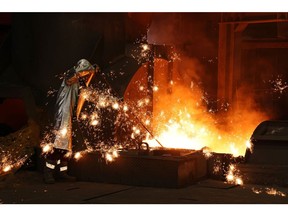Article content
(Bloomberg) — American steel executives say they’re optimistic that demand for the industrial material will rebound next year, recovering from the lackluster demand and low prices that have hobbled the industry in 2024.
Many industry leaders who gathered at the SMU Steel Summit in Atlanta earlier this week said they have high hopes in 2025. They see a turnaround fueled by an improving US economy, as large infrastructure projects get built and interest-rate cuts encourage consumer spending.
Article content
“If it’s a good economy, if people are out buying washing machines, they’re buying cars, they’re buying houses and building commercial buildings,” said Mike Barnett, president of Grand Steel Products Inc., a steel service center based in Wixom, Michigan. “That’s really good for us.”
The US steel industry has been dominated this year by Nippon Steel Corp.’s proposed takeover of United States Steel Corp., the country’s largest producer. The $14.1 billion deal, which has become a hot political issue following opposition from President Joe Biden and union workers, is driven by the Japanese company’s optimism of more growth within the US.
Yet despite the potential for more spending on major energy projects due to government incentives, higher borrowing costs have been a drag on manufacturing and economic growth. Steel demand in the first half of this year was 50.9 million tons, about 0.4% less than the same period a year ago, according to data from the American Iron and Steel Institute.
Benchmark US steel futures are down 37% since the start of the year and earlier in the summer hit the lowest levels since December 2022.
Article content
The Federal Reserve’s signaling of rate cuts as soon as September lifts the prospects of a turnaround for sectors that rely on steel.
“We’re expecting growth in demand domestically here from construction, with all of the investment driven by government policy over recent years,” Kevin Dempsey, president of the American Iron and Steel Institute, said in an interview.
Among those are the Biden administration’s Infrastructure and Investment Jobs Act of 2021, which included mandates to build projects with American steel. Geoff Gilmore, chief executive officer of Columbus, Ohio-based processor Worthington Steel, said the act included $550 billion for projects using steel — equal to about 50 million tons of the material.
“That definitely would be a boost for the sector,” he said in an interview.
Despite the optimism, CRU’s senior steel analyst Alexandra Anderson still sees challenges ahead for the industry. New steel capacity is also set to come online in the coming months in the US, including US Steel’s new Big River 2 plant in Arkansas, that threatens to outpace growth in demand.
Article content
According to the American Iron and Steel Institute, US raw steel production rose 1.1% last year to reach 89.7 million net tons.
The US industry is also dealing with ongoing trade issues, including slumping global prices from an overabundance of Chinese steel and an influx of cheap foreign steel despite protective tariffs. Another wildcard is the US presidential election, pitting Vice President Kamala Harris against Republican nominee Donald Trump.
“One of the features of US elections is investors get a little bit rattled and cautious ahead of the election,” said Tom Price, senior commodities analyst at Panmure Liberum. “Whatever the result is, Trump or Harris, there will be a relief rally after the election.”
Share this article in your social network

